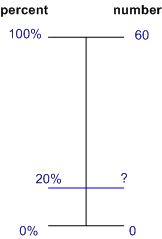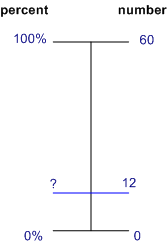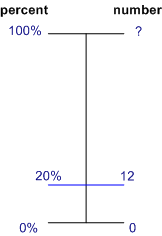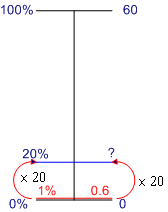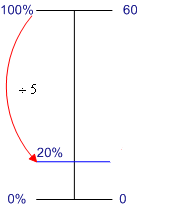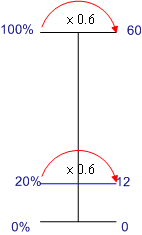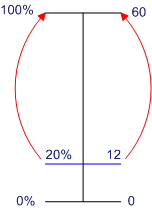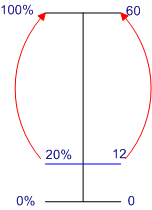Solving Percentage Problems: 5.5
Supporting materials
- Related Progression Points
- Developmental Overview of Numeration: Base Ten and Place Value Properties (PDF - 28Kb)
- Developmental Overview of Proportional Reasoning and Multiplicative Thinking (PDF - 41Kb)
Indicator of Progress
Success depends on students' understanding of the three basic types of percentage problems:
- MISSING PART: finding what quantity is a given percentage of another
- MISSING PERCENT: finding what percentage one quantity is of another
- MISSING WHOLE: finding the whole quantity (ie the 100%) given what percent a certain quantity is.
Students usually find the third problem type more difficult than the first two. Some students find a further difficulty in working with percentages over 100%.
Illustration 1: Problem types
Problem 1: missing part
20% of the books on a shelf of 60 books are cookbooks. How many cookbooks are there? (i.e. what number is 20% of 60?).
Problem 2: missing percent
12 out of 60 books on a shelf are cookbooks. What percentage of the books are cookbooks? (i.e. what % is 12 of 60?).
Problem 3: missing whole
20% of the books on a shelf of books are cookbooks. If there are 12 cookbooks, what is the total number of books on the shelf? (i.e. finding the whole given 12 is 20%).
'Missing whole' problems (like problem 3) are often found by students to be harder than problems of the other two types. The effect is stronger if the numbers and percentages involved are not 'nice'.
Teaching Strategies
The main teaching strategy is to introduce a simple graphical device called the dual number line, which is useful for estimating the answer, organising the data and suggesting solutions. This device can also be used in other proportional reasoning problems, stressing the connections with percentage.
The important thing is to emphasise that all the relationships are proportional (i.e. multiplicative), not additive.
Activity 1: Diagnostic task suggests using a diagnostic test, to see which of the three types of problems need attention.
Activity 2: The dual number line shows how to use the dual number line to teach students to solve all three types of percent problems.
Activity 1: Diagnostic task
Create a set of percentage problems which feature all three types of problems. For each type, include some problems with easy numbers (as in Illustration 1 above) and some without.
Have students solve the problems with calculators allowed. Observe the types of problems that students get correct, incorrect and leave blank.
Activity 2: The dual number line
The dual number line is useful in many proportion and percentage problems. For percent problems, one side of the line is marked with the quantities and the other with the percentages.
The dual number line organises the given information and shows which information is missing in each type of problem. If the dual number line is drawn roughly to scale, it is a great help in estimating – always an important first step to any solution.
|
12 out of 60 books on the shelf are cook books. This means 20% of the books on the shelf are cook books. |
|
|
|
finding the part |
finding the percent |
finding the whole |
|
|
|
|
|
What is 20% of 60 books? |
What percent is 12 out of 60 books? |
12 is 20% of what number? |
Dual number lines can also be used to map out solution paths. There are many different ways to solve these problems, so students will not always use the same method as their teachers. Here are some examples.
Problem 1 (missing part problem)
There are 60 books on the shelf and 20% are cookbooks. How many cookbooks?
|
Solution 1. Unitary method – finding 1% first |
||
|
Step 1: Draw the dual number line |
Step 2: Find 1% |
Step 3: Find 20% |
|
|
|
|
|
There are 60 books on the shelf |
1% is 0.6 books |
20% is 20 × 0.6 = 12 There are 12 cookbooks |
NOTE: A variation, particularly useful in this case, is to find 10% first and then find 20%.
|
Solution 2. Noticing 100 = 5 × 20 |
||
|
Step 1: Draw the dual number line |
Step 2: Notice link between percents |
Step 3: Use link on quantities |
|
|
|
|
|
|
One fifth of 100% is 20% |
One fifth of 60 is 12 There are 12 cookbooks |
|
Solution 3. Using the ratio between 100 and 60 |
||
|
Step 1: Draw the dual number line |
Step 2: Notice link from percent to quantity |
Step 3: Use link from percent to quantity |
|
|
|
|
|
There are 60 books on the shelf and |
|
There are 12 cookbooks |
|
Solution 4. Without noticing any easy links between numbers, but identifying equivalent proportions |
||
|
Step 1: Draw the dual number line |
Step 2: State that both sides of |
Step 3: Solve algebraically |
|
|
|
|
|
There are 60 books on the shelf |
|
|
Problem 2. Missing whole problem.
There are some books on the shelf and 12 are cookbooks. If 20% are cookbooks, how many books are on the shelf?
Although this is the difficult missing 100% problem, this question is not much harder with the use of the dual number line to organise the work.
|
Solution 1. Noticing relationship between 100 and 20 |
||
|
Step 1: Draw the dual number line |
Step 2: Notice the × 5 relationship |
Step 3: Use on other side |
|
|
|
|
|
There are some books on the shelf and 12 |
5 times 20% is 100% |
5 times 12 is 60 There are 60 books. |
|
Solution 2. Using proportional reasoning, without noticing any special relationship |
||
|
Step 1: Draw the dual number line |
Step 2: Write down the relationship |
Step 3: Solve |
|
|
|
|
|
There are some books on the shelf |
|
|
Students can move from solution 1 (special case of simple ratio, such as 100 ÷ 20) to solution 2, but generalise the method. So in solution 2, p = 20, so multiply by 5 to get 100%.
References
Much of this section is adapted from Marston, K. & Stacey, K. (Eds.) (2003). Foundations for Teaching Arithmetic. Version 2. Faculty of Education, University of Melbourne. http://extranet.edfac.unimelb.edu.au/DSME/arithmetic


